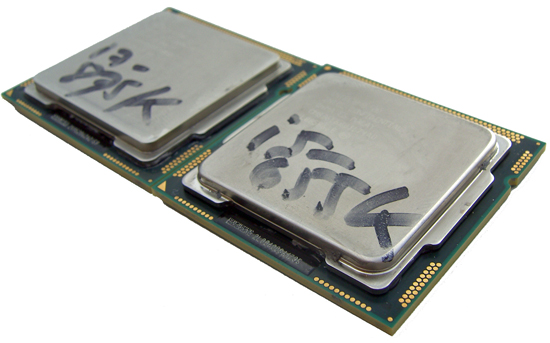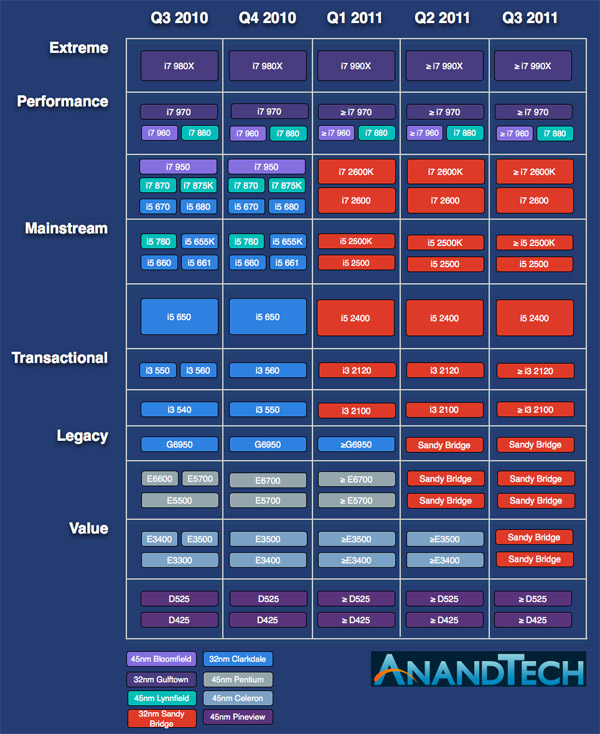Intel's Sandy Bridge Architecture Exposed
by Anand Lal Shimpi on September 14, 2010 4:10 AM EST- Posted in
- CPUs
- Intel
- Sandy Bridge
Multiplier-only Overclocking
There's no new information on Sandy Bridge overclocking at this point (although it's looking increasingly likely that there will be a reasonably priced K-series SKU for those users who want the flexibility to overclock without spending $1000). I've included the overclocking text and roadmap from our Sandy Bridge Preview below if you're interested in seeing what Intel has planned.
It wasn’t until the Pentium II that Intel started shipping multiplier locked CPUs. Before then you could set the multiplier on your CPU to anything that was supported by the line, and if you had a good chip and good enough cooling you just overclocked your processor. Intel’s policies changed once remarking, the process of relabeling and reselling a lower spec CPU as a higher one, started to take off.
While multipliers were locked, Intel left FSB overclocking open. That would be an end user or system integrator decision and not something that could be done when selling an individual CPU. However, ever since before the Pentium III Intel had aspirations of shipping fully locked CPUs. The power of the enthusiast community generally kept Intel from exploring such avenues, but we live in different times today.
Two things have changed Intel’s feelings on the topic. First and foremost is the advent of Turbo Boost. So long as Intel doesn’t artificially limit turbo modes, we now have the ability to run CPUs at whatever clock speed they can run at without exceeding thermal or current limits. We saw the first really exciting Turbo with Lynnfield, and Sandy Bridge is going to expand on that as well. On the flip side, Intel has used Turbo as a marketing differentiator between parts so there’s still a need to overclock.
The second major change within Intel is the willingness to directly address the enthusiast community with unlocked K-series SKUs. We saw this recently with the Core i7 875K and Core i5 655K parts that ship fully unlocked for the overclocking community.

The K-series SKUs, these will be more important with Sandy Bridge
With Sandy Bridge, Intel integrated the clock generator, usually present on the motherboard, onto the 6-series chipset die. While BCLK is adjustable on current Core iX processors, with Sandy Bridge it’s mostly locked at 100MHz. There will be some wiggle room as far as I can tell, but it’s not going to be much. Overclocking, as we know it, is dead.
Well, not exactly.
Intel makes three concessions.
First and foremost we have the K-series parts. These will be fully unlocked, supporting multipliers up to 57x. Sandy Bridge should have more attractive K SKUs than what we’ve seen to date. The Core i7 2600 and 2500 will both be available as a K-edition. The former should be priced around $562 and the latter at $205 if we go off of current pricing.
Secondly, some regular Sandy Bridge processors will have partially unlocked multipliers. The idea is that you take your highest turbo multiplier, add a few more bins on top of that, and that’ll be your maximum multiplier. It gives some overclocking headroom, but not limitless. Intel is still working out the details for how far you can go with these partially unlocked parts, but I’ve chimed in with my opinion and hopefully we’ll see something reasonable come from the company. I am hopeful that these partially unlocked parts will have enough multipliers available to make for decent overclocks.
Finally, if you focus on multiplier-only overclocking you lose the ability to increase memory bandwidth as you increase CPU clock speed. The faster your CPU, the more data it needs and thus the faster your memory subsystem needs to be in order to scale well. As a result, on P67 motherboards you’ll be able to adjust your memory ratios to support up to DDR3-2133.
Personally, I’d love nothing more than for everything to ship unlocked. The realities of Intel’s business apparently prevent that, so we’re left with something that could either be a non-issue or just horrible.
If the K-series parts are priced appropriately, which at first indication it seems they will be, then this will be a non-issue for a portion of the enthusiast market. You’ll pay the same amount for your Core i7 2500K as you would for a Core i5 750 and you’ll have the same overclocking potential.
Regardless of how they’re priced, what this is sure to hurt is the ability to buy a low end part like the Core i3 530 and overclock the crap out of it. What Intel decides to do with the available multiplier headroom on parts further down the stack is unknown at this point. If Intel wanted to, it could pick exciting parts at lower price points, give them a few more bins of overclocking headroom and compete in a more targeted way with AMD offerings at similar price points. A benevolent Intel would allow enough headroom as the parts can reliably hit with air cooling.
The potential for this to all go very wrong is there. I’m going to reserve final judgment until I get a better idea for what the Sandy Bridge family is going to look like.











62 Comments
View All Comments
iwodo - Tuesday, September 14, 2010 - link
Many questions still not answered, may be Anand could found out for us.1. Were the GPU performance we saw from 6 EU or 12 EU?
2. Where is FMA ( Fused Multiply Add ) ? Will we see it in Ivy Bridge?
3. Can All software developers access the Decoding Engine? We could see many codec being optimized for playback on Intel Hardware Decoder, whether it is fully supported codec or partially supported codec.
4. Hardware Encoder? It is Full Hardware encoder? Free to use for Software Dev?
5. OpenCL not possible?
6. How many % die size is given to Graphics?
7. Gfx Drivers, will Intel commit more resources on drivers update? Or Will they open sources it?
Apart from Sandy Bridge, Looking forward for reports on USB 3.0 situations, LightPeak, Gen 3 SSD.
trivik12 - Tuesday, September 14, 2010 - link
1) I believe it was 12EU part.2) FMA will be introduced with Haswell(next tock). So we have to wait until early 2013 for that.
Foo999 - Tuesday, September 14, 2010 - link
> 2. Where is FMA ( Fused Multiply Add ) ? Will we see it in Ivy Bridge?You can check out the full current (and Ivy Bridge) AVX instructions in the AVX reference manual available from software.intel.com/en-us/avx/
spart - Tuesday, September 14, 2010 - link
1 , 6UE The 12 is only for laptops and high rangesgvaley - Tuesday, September 14, 2010 - link
So, was it playable, I mean Starcraft II?therealnickdanger - Tuesday, September 14, 2010 - link
Yeah, the caption said "310M vs Sandy Bridge" so I assume you could see the settings and frames per second. Details, man, details!!:)
Anand Lal Shimpi - Tuesday, September 14, 2010 - link
Yes, it was playable at medium quality settings. They only had the single player campaign running however.Take care,
Anand
Carleh - Tuesday, September 14, 2010 - link
With BCLK locked, where does that leave the motherboard manufacturers?I mean, what are they left to offer to enthusiasts, if the BCLK is locked? How are they going to differentiate an enthusiast-class motherboard from a mainstream one?
ssj4Gogeta - Tuesday, September 14, 2010 - link
Will they be locking the socket 2011 parts as well?Zoomer - Sunday, September 19, 2010 - link
Sell more bullbozer boards. I was all set to be ready to get a nice Sandy Bridge and overclock it to hell, but now I think I'll get a bulldozer instead.Sure there's the K, but it costs more. That kinda defeats the point, unless the aim is to get a high clk for epeen.